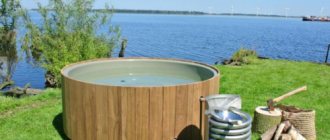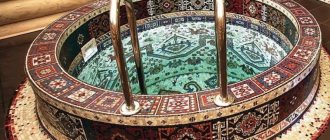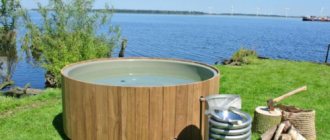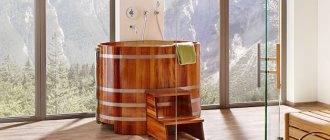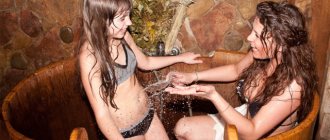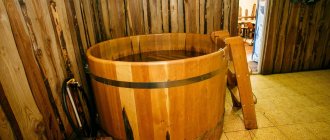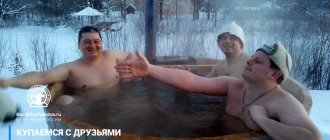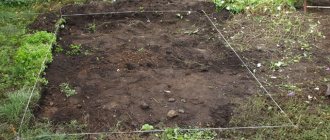Repin’s painting “They Arrived”: a dark room, aromas of medicines, deathly silence, a warm blanket, a mountain of pillows and paper handkerchiefs lying everywhere. Wow, creepy. I think everyone has guessed what this is about? That's right, this is how modern people get sick. But how did people living in ancient times fight physical and mental illnesses? Do not know?
Well, for example, a Russian person would go to a bathhouse, enjoy the steam with lingering notes of fragrant and healing herbs, and then plunge into an ice hole or a barrel, the water in which was considered miraculous, since it absorbed the life-giving properties of wood. And in the Land of the Rising Sun, a person sat in a container with sawdust (ofuro), sweated until exhaustion, after which he moved into a wooden barrel with hot water (furako) and washed himself in it. You can read more about the Japanese bath here.
What did it give? If you believe history, then in picturesque Rus' the heroes had unprecedented strength, and the red maidens had dazzling beauty. In mysterious Japan, samurai were famous for their incredible endurance, and geisha were famous for their witchcraft charm. In principle, each nation had its own methods of healing, but people living in Rus' and Japan seemed to have mastered magic, as the fame of their good health and unearthly beauty spread throughout the world!
Actually, what am I getting at? Tell me, do you want to glow with priceless health and shine with fabulous beauty? Of course. Then take a closer look at the invention that combines Russian and Japanese healing traditions. A heated font in another way, Furako, is a bowl that banishes physical and mental illnesses! Are you intrigued? Great! This is what we will discuss today.
Varieties
Conventionally, there are 3 types of Japanese baths: furako, ofuro and sento. In fact, everything looks different. This classification can only be understood after a more thorough study of each type.
Furaco
The Japanese bathhouse furako involves a voluminous round or oval wooden container in which the procedures take place. A mandatory attribute of the barrel is a heating element. In home versions it is an electric (or more economical gas) heater, in outdoor ones it is a wood heater.
Japanese outdoor bath Source pbs.twimg.com
Interesting! In traditional Japanese baths, the water was always heated with wood.
Inside the container is divided into 2 parts. One is for bathing, the second contains a heating device. There are designs in which the heater is located outside the container. The “font” is equipped with a bench and can accommodate from 1 to 10 people, depending on the size.
Water is heated evenly and can reach 55 degrees or more. For maximum effectiveness of healing properties, herbal infusions, aromatic oils, and flower petals are added to it. Please note that the barrel of a Japanese bath should be made of natural wood; the use of other “dead” materials will not have such healing properties on the body.
Construction of a barrel for a Japanese furako bath Source static.wixstatic.com
The advantages of the Japanese furako bath are as follows:
- Removing waste and toxins released as a result of excessive sweating.
- Stimulation of metabolic processes and immunity.
- Improving skin condition, opening and cleaning pores.
- Normalization of the activity of the heart muscle and blood vessels.
- Prevention and therapy of the genitourinary, nervous systems, musculoskeletal system, respiratory organs.
Healthy! When arranging a furaco bathhouse in the garden, it is advisable to provide a lid. This will prevent foreign debris, dust, and leaves from entering during its downtime.
Ofuro
Healthy! Ofuro bath is called the best natural procedure for rejuvenation and weight loss.
In most cases, it is made in the form of a rectangular wooden box with a side height of 50-60 cm. Ash, cedar or oak are used as materials for assembly. The lower part is equipped with a heating system with a thermostat.
A kind of font is filled with sawdust and shavings, into which a person immerses. To increase the healing effect, medicinal herbs, aromatic oils, roots, and essential oils are added. The composition is heated to a temperature of 45-55°C.
Wooden container for Japanese ofuro Source banya-expert.com
During the procedures of the Japanese bath ofuro, a person is immersed in the mixture and stays inside for 10-30 minutes. During this time, the process of accelerated sweating begins, when increased release of toxins and salts absorbed by the shavings occurs.
Immersion in heated sawdust Source sdelatbanyu.ru
At the same time, wood releases beneficial substances and volatile compounds that have a positive effect on the body. Germs are destroyed, wound healing is accelerated, and irritation is relieved. Aromatic components help improve metabolism and can slow down the aging process of the epidermis.
Heated hot tub - design choice
The idea of combining business with pleasure and building an outdoor swimming pool with water heated from a fire source is not new. Such designs have been known since antiquity. For example, Japanese Furako (Ofuro).
In addition to the healing effect, an outdoor font decorates a suburban area.
Fonts are placed next to the house or bathhouse.
On the open terrace.
The font bowl is made of plastic: polyethylene, polypropylene, with a fiberglass liner, or wood, which is considered less hygienic.
A wood stove is placed nearby.
Or mounted inside the font.
The internal oven, unlike the external one, takes away the useful volume from the font. Such a stove is more difficult to light and clean.
People prefer free-standing hot tubs with an external stove.
But such bathtubs from the manufacturer, if you buy them, cost a pretty penny. The solution is to roll up your sleeves and make a hot tub yourself, as Pit7pit did.
The user’s font is not a cheap “toy,” but at the end of the article, along with the estimate, we will tell you how to reduce the costs of its construction.
It all started with “wants”.
Pit7pitFORUMHOUSE user
I want to make an outdoor winter plunge pool for myself and my wife. I took as a basis an old cast iron bathtub “Made in the USSR” weighing 100 kg. I brought her to the station. I barely unloaded it. I figured out how and what. The next idea is to weld a frame from metal pipes. Place a bathtub into this podium, 4x5 m. Make a barbecue type stove underneath it. Bring the chimney through the podium, not forgetting about fire safety, and cover the structure with a board. Next: I pour water into the bath and light a fire in the stove. I'll add herbs to the water for flavor. I plunge into the heated water and feel blissful in nature, in the fresh air. Well, in the summer, I use the plunge pool as a mini-pool, and sunbathe on the plank flooring. What do you think of the idea?
The user was puzzled by the following questions:
- Will a cast iron bathtub withstand temperature changes?
- Will the metal burst in the cold?
- How to weld a stove to cast iron without cracks, so that the flames and smoke go only into the chimney?
- How to calculate the size of a "potbelly stove"?
Without waiting for answers, because... an outdoor hot tub is a rarity, Pit7pit built it himself, picking up some “bruises and bumps” in the process.
What is included in a visit to a Japanese bath?
The popularization of Japanese life and wellness procedures as an effective method in the pursuit of beauty and rejuvenation of the body has made furako and ofuko one of the most popular in modern spa salons. Let's look at a standard service package using a specific example.
Important! A package of additional services (massage, aromatherapy, gymnastics, lifting, etc.) is not considered in this case, since we are talking only about a bathhouse.
Ablution
At the first stage of the Japanese bath, a person is immersed in a huge wooden furaco barrel filled with hot water, the temperature of which must be at least 50 ° C. However, before entering the “font” you must take a shower and cleanse your body of dirt and sweat.
Interesting! Despite the fact that the Japanese baths ofuko and furako are called saunas, they do not involve washing procedures. Their main purpose is relaxation and treatment.
After a shower, a person is placed in a Japanese furaco barrel filled with moderately heated water (35-41°C). Only after the body “adapts” to the temperature does the thermal effect begin to increase. The heating of the liquid increases evenly and reaches 50°C. The process can occur in 2 ways:
- By transplanting from one barrel (with “cool”) water to another, with “hot” water.
- The entire cycle is carried out in one barrel with a built-in heating system and a temperature controller, which controls the temperature.
Immersion in hot water without preheating can cause burns and dizziness.
Important! During a visit to a Japanese bathhouse in an unfamiliar spa, the first thing you notice is the number of barrels. The only container into which boiling water is immediately poured is evidence of a violation of Japanese traditions and the quackery of the institution.
Japanese bath in a spa salon Source fitorelax.ru
Building a winter font: step by step and with pictures
The design of the outdoor font is simple. The principle of operation is shown in the photo below.
The water is heated in a wood stove and circulates naturally through the pipes.
Taking this scheme as a basis, Pit7pit began construction. Step by step process:
- Vertical pipes were buried in the ground and the frame was welded. The height of the podium is 1500 mm.
The technology for installing pipes is the same as when installing fence posts. To concrete them or not depends on the type of soil - heaving - not heaving. A universal option for problematic soil is screw piles.
- The frame was covered with boards.
- The boards were burned with a gas torch until they were black.
- Brushing wood with a grinder and brush.
- The wooden podium of the font was painted with stain.
The tap for draining water is visible from below.
The font was half sunk into the podium. Water is poured through the stove drain valve. This way her temperature rises faster.
- The benches were made of wood.
In order not to break the seal of the bowl, the boards were screwed with self-tapping screws at the very top of the font.
- We purchased a ready-made lid.
The purchased version turned out to be better than the homemade one.
Pit7pitFORUMHOUSE user
At first I installed the oven flush with the base of the font, but the convection is weak. I moved the stove 15 cm lower. The water circulates perfectly. The hoses are slightly inclined.
After installing the stove, the font was finally refined and this is what ended up happening.
Another photo of the outdoor swimming pool.
And further.
To reduce heat loss from the “mirror” and quickly reach operating mode, the water in the font is heated with the lid closed.
First test of the font. October 2015. It’s 3 degrees outside and there’s a strong wind.
The hot tub comfortably fits four people. Six people can get in, but then you won’t be able to swim in the font.
The font looks especially impressive in winter.
To get maximum pleasure from water procedures in the open air, the user advises taking with you a food set - tea, mineral water, juice, and for mood - a radio.
In the summer you can sit on the podium as if on the captain's bridge, admire the site and drink tea or coffee.
Benefits and contraindications
The benefits of the Japanese bath, culture and life in general are confirmed by the fact that the Japanese are among the leading countries in terms of life expectancy. In 2022, the American Central Intelligence Agency (CIA) published analytical information about the entire population of the globe. According to the data, in Japan this value is 87.3 years (in Russia 72.9).
The healing Japanese bath process also makes a certain contribution to long life. The most visible effects on the body include the following:
- Strengthening the immune system.
- Prevention and treatment of colds.
- Restore strength, relieve fatigue, nervous excitement.
- Charging with a good mood, relieving stress.
- Improved metabolism.
- Cleansing from salts and toxins.
- Skin rejuvenation.
- Losing weight.
Visiting the Furako and Ofuko baths is contraindicated for the following problems:
- Skin diseases.
- Chronic, infectious and aggravated diseases.
- High blood pressure.
- Oncology.
- Epilepsy.
- Pregnancy.
- Individual intolerance to individual components.
Important! As can be seen from the list presented, there are enough contraindications to visiting a Japanese bath. Therefore, before your first visit, we recommend that you consult with your doctor or therapist.
How to improve an outdoor hot tub with a wood-burning stove
The operation of the font revealed bottlenecks that need to be improved. Because In winter they swim mainly in the dark, Pit7pit made decorative lighting from LED strip.
The user recommends using warm white light, it is most comfortable for the eyes.
One more thing.
Pit7pitFORUMHOUSE user
The two-meter lid is difficult to lower and raise manually. So I built a roof over the font and built a lifting block mechanism into it.
Ready-made version of the roof over the font.
The canopy over the font does not interfere with admiring the surroundings or the starry sky, and protects from precipitation. To secure the cover in the upper position, safety pins are used (the fasteners are made at 4 points for safety).
According to the user, the maximum temperature at which he swam was up to -15 °C. If you want to swim at a lower temperature, solve the issue of filling the bowl with water, because... the hose, 30 m long, gets caught in the frost. The solution is to throw in a heating cable.
What else can be improved in the font:
- Heat the hoses going from the hot tub to the stove if the temperature outside is lower than -10 °C.
- Provide a slight tilt of the font towards the drain, this makes it easier to wash the bowl.
Another plus of the font is that there is a utility building under the podium. The height of the “shed” is 1.5 m. The user stores there everything that is not afraid of water: barrels, buckets, gardening tools, etc.
Construction and finishing
Any construction begins with laying the foundation. For a separate ofuro bath, it must be calculated in accordance with the soil characteristics of the site and the climatic conditions of the region.
To build a Japanese bathhouse on a site with maximum cost savings, it is best to choose a pile or columnar foundation. The support piles are installed below the soil freezing line using concreting, backfilling or a combined method. The grillage can be made of wood, metal or concrete. However, the last two options can withstand a much heavier structure.
Pile foundation for a one-story log bathhouse
The walls and roof of the bath complex are made of various types of wood, but it must be selected, that is, without the slightest defect. Cedar and oak are best suited for this, but larch, pine and other resin-producing species are not recommended. In most cases, aspen, poplar or linden are used to decorate the walls of an ofuro bathhouse, although other hardwoods can also be used.
Interior design of the ofuro bathhouse in the photo
[wonderplugin_gridgallery id=”20"]
The roof of the bathhouse can have an attic space, and its shape can be single- or gable. First, the ceiling is always erected and only after that the construction of the roof begins. Work can be performed both on the ground and directly on the frame of the building.
Furaco, that is, a font designed for 1200 - 1500 liters of water, will weigh 200-250 kg. The same applies to ofuro - a container for heating with sawdust. Together with the latter, she will weigh about three times more than an ordinary person. This, as well as all other loads, should be carefully taken into account when constructing the floor. In the process, water supply and sewerage systems, as well as heating, are installed under the main elements of the complex. All engineering communications, including electrical, are laid in accordance with current standards. And most importantly: doors and windows in a Japanese bath should also be made of wood.
Laying the floor in the bathhouse
Japanese approach to bathing
Bath font in Japanese
According to historians, the ofuro bath tradition owes its origin to the harsh Japanese climate. The Land of the Rising Sun is an island washed by cold seas and the Pacific Ocean. The weather here is always humid, the winter is chilly, and the rainy periods are quite prolonged with all the ensuing consequences. During the cold season, the air temperature in Japan drops to -40°C, which, together with the piercing sea wind, causes many diseases.
In such conditions, warming up the body after being outside becomes vital. And since firewood and coal, by Japanese standards, are quite expensive and very scarce materials, representatives of this eastern culture had no choice but to invent ofuro.
A Japanese bath is a wooden barrel of water placed on a stove that heats the liquid to the required temperature. The material chosen for the container is not at all simple - traditionally it was created from pine, cedar and larch, less often - oak and other valuable species that can retain heat. Inside the barrel there are seats on which you can sit relaxed or lie in a reclining position.
Font with internal benches
As a rule, a bath is taken for 5 minutes, which is quite difficult to endure if you are not used to it. However, more hardy lovers of bath procedures can easily afford to soak in the water for about 10-15 minutes. It is recommended to dive gradually to a level below the heart, and in the process of getting used to the water, incomparable physical relaxation occurs.
Since the temperature of the water in the barrel must be within the 45°C range of the stove on which it is installed, there is a risk of thermal shock. To avoid this, the person taking the bath must put a felt cap on his head, previously soaked in cold water.
Felt bath cap

